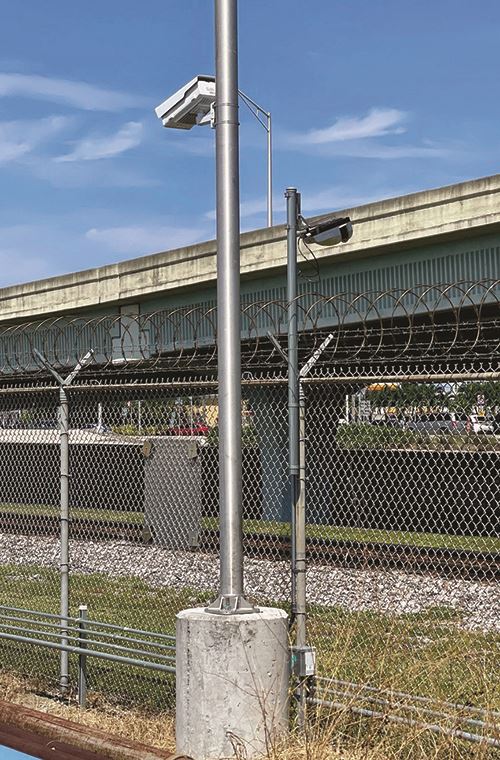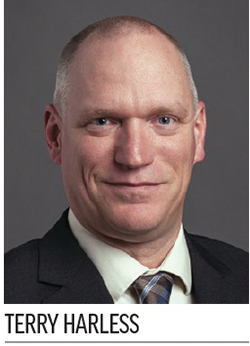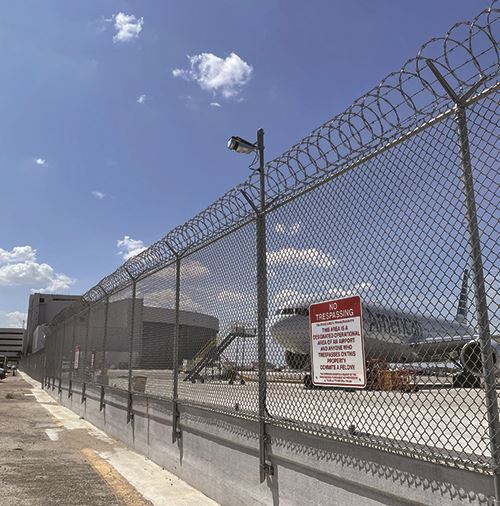Miami Int’l Tests Perimeter Intrusion Detection and Deterrence Technologies

Miami International Airport (MIA) is one of two locations partnering with TSA to evaluate cutting-edge perimeter intrusion detection and deterrence technologies. The tools being tested—video surveillance, video analytics, laser walls, ground-based radar, etc.—were integrated into the existing security and operations center at MIA for a two-year pilot program designed to eventually benefit airports throughout the United States. The other pilot location is San Jose International Airport (SJC).
 Prior to this project, MIA had enhanced its 13.1-mile perimeter in March 2021 with concertina razor wire atop fencing that surrounds the 3,200-acre urban airport. “The perimeter is always an obvious area where we look for vulnerabilities and where we look for ways to close those vulnerabilities and to enhance the protection our perimeter line gives us,” says Miami-Dade Aviation Department Director of Security Mark Hatfield.
Prior to this project, MIA had enhanced its 13.1-mile perimeter in March 2021 with concertina razor wire atop fencing that surrounds the 3,200-acre urban airport. “The perimeter is always an obvious area where we look for vulnerabilities and where we look for ways to close those vulnerabilities and to enhance the protection our perimeter line gives us,” says Miami-Dade Aviation Department Director of Security Mark Hatfield.
The new systems installed at MIA for the pilot project cost approximately $6.26 million. Funding came from the Perimeter Protection Project, which was established through the Consolidated Appropriations Act of 2018. It granted a one-time lump sum of $10 million for TSA to develop a multi-year plan to analyze and test perimeter intrusion detection and deterrence technologies in partnership with airports. “Should more funding be made available, TSA will be ready to replicate the program with other airports,” says Jim Bamberger, TSA branch chief for the Public Area Security Infrastructure Protection Branch.
|
facts&figures Project: Testing Perimeter Intrusion Detection & Deterrence Technologies Location: Miami Int’l Airport Size: ~30,000 ft. of perimeter fence Cost: $6.26 million Design: May 2019–Aug. 2020 Construction & Installation (Phase One): Feb. 2021–July 2023 Key Components: Video surveillance via thermal cameras, fixed-view cameras, bi-spectral cameras, pan-tilt-zoom cameras & multi-sensor cameras; video analytics; laser walls; fiber optic sensors
Design & Prime Engineer:
General Contractor:
Programming & Integration:
Camera Technology:
Technology Analytics: Key Benefits: Increased security from additional perimeter intrusion detection & deterrence technologies; forensic information to enhance response efforts & after-incident review |
Results from the project will provide critical capability for evaluating the operational performance and suitability of installed technologies in airport environments, Bamberger explains. TSA will use data from MIA and SJC as benchmarks to help other airports identify their perimeter vulnerabilities and help improve security.
Results from the pilot program’s two-year data collection period will be published in late fiscal year 2025 or early 2026. The final report will include detailed data findings, insights, best practices and lessons learned, and will be distributed to airports, Department of Homeland Security partners and local security providers. The report is intended to help airports and their project partners make informed procurement decisions by proving them with unbiased information about the capabilities and limitations of various technologies.
Preparation, Planning and Teaming Up
Beginning in 2019, personnel from TSA and the Naval Surface Warfare Center of Panama City worked closely with MIA to define the scope of the pilot project and recommend specific systems and technologies for testing. In Phase One, they helped the Miami-Dade Aviation Department select 58 zones along critical sections of about half of the airport perimeter for installation of new equipment. Phase Two, which addresses the rest of MIA’s perimeter, will be designed and installed over the next two years.
The team also worked to identify elements that could potentially create false alarms, such as wildlife, wind-born debris and adjacent vehicle traffic. “That’s a really important weakness that you need to keep an eye on and be able to design against and create concepts of operations to obviate that condition,” Hatfield says.
After basic design recommendations were made, Miami-Dade Aviation Department entered into an “other transaction agreement” with TSA in January 2020. Burns & McDonnell provided design services and acted as project manager and prime engineer.
Multiple levels of law enforcement have also been involved from the beginning of the project. “It’s been a partnership with TSA and certainly our local law enforcement, Miami-Dade Police Department and the U.S. Air Marshals out of TSA,” Hatfield notes. “We do joint vulnerability assessments on a periodic basis, and the federal air marshals take the point on that. We really take a holistic look at the airport to identify potential areas of vulnerability.”
Fence penetrations by vehicles or individuals, and near penetration by drones, provide situational awareness and understanding of the property’s vulnerabilities. “Every year brings with it knowledge and learning,” Hatfield remarks.
Certified Network Professionals, MIA’s long-term security integrator, began improving the network infrastructure in May 2020 to support the pilot project and other upgrades at the airport. After construction plans and designs were approved for Phase One, the airport received its notice to proceed from TSA in February 2021. Certified Network Professionals began planning and design in April 2022 and completed upgrades to the network in December 2022. Testing was completed in March 2023 on the north side and May 2023 for the south side.
Construction work and technology installation for Phase One was completed in July 2023. Now, MIA is in the two-year data collection period while simultaneously moving onto Phase Two for additional sections of the perimeter.
Putting Technology to Work
The technologies being tested serve two main purposes: to alert the airport of potential breaches, with specific information about the location and trajectory of intruder(s); and reduce false alarms by requiring dual confirmation of a breach.
 The diverse landscape along the perimeter at MIA made planning, design and installation a challenge, but will ultimately yield more information. “Every location that we looked at provided its own different challenges, so that variation helped the project,” says Orlando Suero, president and network/systems engineer at Certified Network Professionals. “I think it provided a really good baseline for future development at other airports.”
The diverse landscape along the perimeter at MIA made planning, design and installation a challenge, but will ultimately yield more information. “Every location that we looked at provided its own different challenges, so that variation helped the project,” says Orlando Suero, president and network/systems engineer at Certified Network Professionals. “I think it provided a really good baseline for future development at other airports.”
The team deployed multiple technologies based on the unique environment and conditions of specific sections of the perimeter. Sensing technologies include laser arrays and fiber-optic sensors; monitoring technology includes a wide variety of cameras. Often, they work together. For instance, video and imagery from the cameras are paired with detection from the laser wall located a couple feet from the fence that senses when someone is approaching the perimeter. “If those two technologies detect something around the same time, it sends an alarm back to the security operations center,” says Terry Harless, senior physical security specialist at Burns & McDonnell. “It has the smarts to understand what a person or a vehicle is, rather than some other object.” An early warning alarm notifies airport staff that someone has penetrated the boundary line so they can use integrated pan-tilt-zoom cameras to view the area, follow the person’s movement and dispatch personnel to intervene if needed.
Other areas of the fence line with less lighting use fiber-optic sensor detection to detect objects at the perimeter, again integrated with visual and thermal pan-tilt-zoom cameras. When the fiber-optic sensor detects an object, the cameras engage automatically and airport staff can assume control of the cameras to follow the object or person.

Axis Communications provided thermal cameras, fixed-view cameras, bi-spectral cameras, pan-tilt-zoom cameras and multi-sensor cameras for the project. “These cameras are very purpose-built to be incorporated in different areas in the aviation landscape, especially for perimeter events,” says Anthony Incorvati, the company’s leader of business development–transportation for the Americas. The equipment has an open platform so third-party developers like Evolon Technology can create applications for the cameras. Often, the company’s analytics are used for long-range detection and tracking. “Because some airports have extensive and complex perimeters, using advanced technologies will augment overall perimeter security strategies,” Incorvati notes.
In-camera video analytics software called Evolon Edge is being used at MIA as a plugin that essentially expands the capabilities of surveillance cameras. “Without additional hardware, security operators can run analytics at the edge,” says Mike Intag, sales director for Evolon Technology. “There is zero delay in intrusion alerts for Miami International Airport since nothing leaves the airport network.” The analytics can automatically drive a pan-tilt-zoom camera, so that when there is an incident, the camera will track the intruder without needing intervention from an equipment operator.
Intag notes that such systems are especially suitable for perimeter fence line protection because they provide long-range detection range (over one mile) versus typical analytics that require cameras every 100 to 200 feet. Recently, the company has been working with a large international airport in the Southeast to test “tailgating” analytics on a 180-degree Axis camera at authorized vehicle gates. This system, which can be implemented with the addition of a single camera, helps prevent multiple vehicles or people from entering security gates with a single badge swipe.
Unauthorized activity first must be identified—hopefully at a low false positive rate—and then the sensor instructs cameras to move in the zone where it occurred and view the area. At that point, security personnel assess and analyze the potential threat. In one instance, MIA staff received a notification from the east side of the airfield and began viewing a live video stream of someone in a fueling truck who had passed a hose from the truck through a gap in the fence or under the fence. “This individual was literally pumping gas through the fence to a vehicle on the other side,” Hatfield recalls. “We were able to go out and stop that activity and issue the individual a fine for breaking the rules.”
The new technologies also offer forensic benefits. After an incident, airport personnel can review video and data that were captured to establish timelines and locations.
Impact on Airport Staff, Travelers
The new perimeter intrusion detection and deterrence technologies at MIA have initially required additional staffing to monitor the system and react accordingly to alerts and notifications. After three to six months of operation, the team will determine whether additional staffing is needed on an ongoing basis.
The improved perimeter fences also will likely require more maintenance than before. The new concertina wire tends to collect debris and garbage, which could potentially cause false alarms.
The timing of this perimeter security pilot coincides with MIA developing a combination airport operation/emergency operation center. “I think that evolution in our internal structure and capabilities with the inclusion of this perimeter intrusion detection system may yet again impact how much personnel it takes to use it,” Hatfield says. “We’ll have the opportunity there where we will be more integrated with our other partners in the airport.” The new center will contain all operating units of the Aviation Department in one area, while the emergency operations side will house U.S. Customs and Border Protection, TSA, Miami-Dade Fire Rescue, Miami-Dade Police and others involved in security and emergency response.
To the average traveler at MIA, the new perimeter security systems will be completely transparent. “But the aviation junkies who read trade magazines and know about it will travel with greater peace of mind, knowing that this is a well-fortified and secured airport,” Hatfield says.
Adjustments and Analysis
With Phase One installation complete in August, Miami-Dade Aviation Department has already learned some valuable lessons regarding limitations of the radar that was evaluated on the southern perimeter. “There were conditions down there that created a lot of ‘noise’ and forced us to go back to redesign and reevaluate the deployment,” Hatfield explains. “We’re already gathering important information that TSA can share with other airports.”
When crews began installing equipment on the mounting poles, they realized the positioning didn’t make sense in some instances and turned the equipment accordingly. If cameras and detectors do not face the ideal direction, the airport would still benefit from early warning alarms and forensic information but would likely encounter more false alarms.

For example, detection equipment installed close to the fence could produce false positives when trains run on tracks along the perimeter or there is a lot of activity on roads just beyond the perimeter. In that case, installers turned the sensors around to detect someone (or something) the moment they drop down inside the fence. “One of the great teachings from this is the more you can know your environment before you get into this, the better prepared you will be when you’re designing and ultimately implementing these kinds of security systems,” Hatfield says. “Every airport has a truly unique environment around it.”
Beyond traffic, machinery noise and other normal activity near MIA’s perimeter, regional wildlife had to be taken into consideration as well. New technologies can evaluate threats based on size, weight or height, so it can ignore small animals like birds, burrowing creatures and rabbits. Previous systems had difficulty differentiating between animal and human activity. “That was clearly a concern and a weakness that we wanted to engineer and design out of it before we even put a shovel in the ground,” Hatfield remarks.
For the next two years, TSA will gather and interpret data to determine the efficacy of technologies implemented at MIA and SJC. Specific brands and models of equipment will be evaluated, from laser arrays to thermal imaging systems.
Miami-Dade Aviation Department is grateful that it was selected for this pilot and other previous security trials. “We are certainly proud of the fact that TSA sees us as a proving ground and a test-bed,” says Hatfield. He’s even amused at the catchphrase, “If they don’t break it in Miami, it should work everywhere.”
Challenges and Opportunities
The different environments on each side of MIA present different challenges. Along the east side, an active taxiway and apron area comes right up to the fence. There is also a massive central maintenance hangar with aircraft continually moving in and out, right alongside a canal and state highway. The north border is lined with hangars, office buildings and warehouses. In many cases, security equipment was attached to tenant facilities, requiring the involvement and coordination of many stakeholders.
The south perimeter is more of an open field, so contractors had to span great distances when bringing in infrastructure. At the direction of Burns & McDonnell, crews used a directional boring process to shoot conduit pipe under the ground and move laterally along the length of the perimeter. Because it was MIA’s first time using the boring method (rather than conventional open-cut excavation), Burns & McDonnell and the Aviation Department went through months of background research. “It was a very long, tedious search to go through decades and decades of documents on infrastructure and piece together where the obstacles, barriers and sensitive items were,” Hatfield recalls.
 Despite the additional planning upfront, the strategy ultimately saved time during Phase One. “We used directional boring to install all the electrical conduit,” says Mauricio Paredes, senior civil engineer and project manager with Burns & McDonnell. “That really expedited the construction.”
Despite the additional planning upfront, the strategy ultimately saved time during Phase One. “We used directional boring to install all the electrical conduit,” says Mauricio Paredes, senior civil engineer and project manager with Burns & McDonnell. “That really expedited the construction.”
Because the directional boring method proved successful, it will likely be used again, where appropriate, during Phase Two on the north and west sides of the airport. “Knowing what we know now, there’s a lot that we can utilize that we have in our back pocket to make at least the design and initial construction a lot more efficient in the future,” says Harless, also of Burns & McDonnell.
 Another challenge involved slight changes that occurred to fence line over the course of the project. Between the initial design and the time crews installed technology about one year later, some areas of the fence got pushed out (perhaps from maintenance vehicles) and some sections of the wire on top became loose. “There are always challenges when it comes to installing new stuff on existing facilities or infrastructure, but I think overall it actually went pretty smooth,” Harless remarks.
Another challenge involved slight changes that occurred to fence line over the course of the project. Between the initial design and the time crews installed technology about one year later, some areas of the fence got pushed out (perhaps from maintenance vehicles) and some sections of the wire on top became loose. “There are always challenges when it comes to installing new stuff on existing facilities or infrastructure, but I think overall it actually went pretty smooth,” Harless remarks.
Despite ample planning, the team still had to make adjustments in the field. “Every detail was important to get accurate results from these products,” explains Mike Gonzalez, business development manager with Certified Network Professionals.

“Unfortunately, most challenges are usually discovered once you’re testing and after everything has been installed; so you have to go physically move sensors and fields of view, and that does impact your schedule and your costs.”
To fine-tune the overall system, crews experimented with camera placement to maximize the capabilities of each unit and stretch the perimeter security detection. In addition, Evolon seized the opportunity to pair its tracking technology with specific cameras. “The combination of color and thermal cameras with Evolon detection and PTZ (pan, tilt, zoom) tracking makes for a robust overall intrusion detection system,” says Intag.
Not surprisingly, MIA had other construction occurring on the airfield during the first phase of the TSA pilot. “We ran into two or three construction projects and had to do a lot of coordination during design and construction,” notes Paredes.

Any project that removes a portion of the perimeter fence must replace that section according to design standards the Aviation Department developed a few years ago, which require extra barriers to repel vehicle intrusions. Gates must include arrestors to prevent vehicles from crashing through.
Lessons Learned
Improving perimeter security isn’t as simple as installing cameras and hoping for the best. “You really want to have as high a level of accuracy and responsiveness from the system as you can get, with a low level of false positives,” Hatfield notes. “That’s a driving set of goals that starts and ends from the design to the execution of the project.”
Adding video analytics helps achieve those goals and also produces forensic evidence that is invaluable if an incident occurs that requires reaction and/or investigation, Intag adds. “Speaking with many airports in recent months, the number-one challenge they face is not having the infrastructure or budget to support adding numerous cameras around their perimeter fence line,” he says. Evolon is working with partners, such as Betacom, that provide solar and wireless equipment to support the installation of Axis cameras running Evolon Edge software at a lower cost that was not previously possible.
Gonzalez counsels airports against looking for a one-size-fits-all solution. Some systems are designed to facilitate quick response after a breach, while others work to proactively identify threats before they become active risks. Both have value. “The manufacturers involved in this project have proven technologies that can give pretty much any airport the results they need if it’s modified, adjusted and tweaked for that particular deployment,” he adds.
 Sergio Faundez, system implementation and operations manager at Certified Network Professionals, emphasizes the need for finesse. “It’s easy to get sensors to alert, but it’s not easy to get them to alert only when you want them to; so consistency is key.”
Sergio Faundez, system implementation and operations manager at Certified Network Professionals, emphasizes the need for finesse. “It’s easy to get sensors to alert, but it’s not easy to get them to alert only when you want them to; so consistency is key.”
Suero, also from Certified Network Professionals, notes that MIA’s Innovation Group encourages project partners to offer non-traditional suggestions. “It’s created a culture at the airport that truly allows contractors like ourselves to cooperate with other personnel and look for different solutions,” he explains. When challenges arose during Phase One of the pilot, Suero felt comfortable suggesting new products and strategies to Maurice Jenkins, who heads the Innovation Group. “That only happens when there’s a willingness from the people that make those decisions to put effort toward problem-solving activities,” he says. “They somewhat embrace those challenges because they understand that innovation is something they want to promote, because that’s the way the best solutions are finally found.”
 Because this pilot is under the wing of TSA, its mission extends well beyond securing the perimeter at MIA. “It’s about sharing, and it’s about testing technologies,” Incorvati says. “The purpose of this is to help the aviation industry as a whole.”
Because this pilot is under the wing of TSA, its mission extends well beyond securing the perimeter at MIA. “It’s about sharing, and it’s about testing technologies,” Incorvati says. “The purpose of this is to help the aviation industry as a whole.”
“Any airport interested in updating their perimeter with detection will have unbiased data on how the technologies perform and vulnerabilities that should be accounted for,” Bamberger adds. Airport stakeholders can reach out to TSA with questions about specific technologies.
2022 Charlotte Douglas International Airport Report of Achievement
 Giving back to the community is central to what Charlotte Douglas International Airport and its operator, the City of Charlotte Aviation Department, is about, and last year was no different.
Giving back to the community is central to what Charlotte Douglas International Airport and its operator, the City of Charlotte Aviation Department, is about, and last year was no different.
Throughout 2022, while recovering from the COVID-19 pandemic, we continued our efforts to have a positive impact on the Charlotte community. Of particular note, we spent the year sharing stories of how Connections Don't Just Happen at the Terminal - from creating homeownership and employment opportunities to supporting economic growth through small-business development and offering outreach programs to help residents understand the Airport better.
This whitepaper highlights the construction projects, initiatives, programs and events that validate Charlotte Douglas as a premier airport.
Download the whitepaper: 2022 Charlotte Douglas International Airport Report of Achievement.








